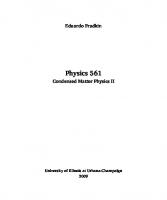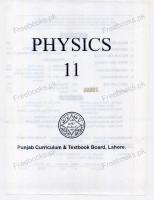Many-Particle Physics [3 ed.] 0306463385
Mahan's Many-Particle physics, with manually added table-of-contents.
344 93 13MB
English Pages 785 [799] Year 2000
Table of contents :
Table of Contents
1. Introductory Material
1.1. Harmonic Oscillators and Phonons
1.2. Second Quantization for Particles
1.3. Electron-Phonon Interactions
1.3.1. Interaction Hamiltonian
1.3.2. Localized Electron
1.3.3. Deformation Potential
1.3.4. Piezoelectric Interaction
1.3.5. Polar Coupling
1.4. Spin Hamiltonians
1.4.1. Homogeneous Spin Systems
1.4.2. Impurity Spin Models
1.5. Photons
1.5.1. Gauges
1.5.2. Lagrangian
1.5.3. Hamiltonian
1.6. Pair Distribution Function
Problems
2. Green’s Functions at Zero Temperature
2.1. Interaction Representation
2.1.1. Schrodinger
2.1.2. Heisenberg
2.1.3. Interaction
2.2. S Matrix
2.3. Green’s Functions
2.4. Wick’s Theorem
2.5. Feynman Diagrams
2.6. Vacuum Polarization Graphs
2.7. Dyson’s Equation
2.8. Rules for Constructing Diagrams
2.9. Time-Loop SMatrix
2.9.1. Six Green’s Functions
2.9.2. Dyson’s Equation
2.10. Photon Green’s Functions
Problems
3. Nonzero Temperatures
3.1. Introduction
3.2. Matsubara Green’s Functions
3.3. Retarded and Advanced Green’s Functions
3.4. Dyson’s Equation
3.5. Frequency Summations
3.6. Linked Cluster Expansions
3.6.1. Thermodynamic Potential
3.6.2. Greens Functions
3.7. Real-Time Green’s Functions
3.7.1. Wigner Distribution Function
3.8. Kubo Formula for Electrical Conductivity
3.8.1. Transverse Fields, Zero Temperature
3.8.2. Nonzero Temperatures
3.8.3. Zero Frequency
3.8.4. Photon Self-Energy
3.9. Other Kubo Formulas
3.9.1. Pauli Paramagnetic Susceptibility
3.9.2. Thermal Currents and Onsager Relations
3.9.3. Correlation Functions
Problems
4. Exactly Soilvable Models
4.1. Potential Scattering
4.1.1. Reaction Matrix
4.1.2. TMatrix
4.1.3. Friedels Theorem
4.1.4. Impurity Scattering
4.1.5. Ground State Energy
4.2. Localized State in the Continuum
4.3. Independent Boson Models
4.3.1. Solution by Canonical Transformation
4.3.2. Feynman Disentangling of Operators
4.3.3. Einstein Model
4.3.4. Optical Absorption and Emission
4.3.5. Sudden Switching
4.3.6. Linked Cluster Expansion
4.4. Bethe Lattice
4.4.1. Electron Green’s Function
4.4.2. Ising Model
4.5. Tomonaga Model
4.5.1. Tomonaga Model
4.5.2. Spin Waves
4.5.3. Luttinger Model
4.5.4. Single-Particle Properties
4.5.5. Interacting System of Spinless Fermions
4.6. Polaritons
4.6.1. Semiclassical Discussion
4.6.2. Phonon—Photon Coupling
4.6.3. Exciton—Photon Coupling
Problems
5. Homogeneous Electron Gas
5.1. Exchange and Correlation
5.1.1. Kinetic Energy
5.1.2. Hartree
5.1.3. Exchange
5.1.4. Seitz’s Theorem
5.1.5. Σ^(2a)
5.1.6. Σ^(2b)
5.1.7. Σ^(2c)
5.1.8. High-Density Limit
5.1.9. Pair Distribution Function
5.2. Wigner Lattice
5.3. Metallic Hydrogen
5.4. Linear Screening
5.5. Model Dielectric Functions
5.5.1. Thomas—Fermi
5.5.2. Lindhard, or RPA
5.5.3. Hubbard
5.5.4. Singwi-Sjolander
5.5.5. Local Field Corrections
5.5.6. Vertex Corrections
5.6. Properties of the Electron Gas
5.6.1. Pair Distribution Function
5.6.2. Screening Charge
5.6.3. Correlation Energies
5.6.4. Compressibility
5.6.5. Pauli Paramagnetic Susceptibility
5.7. Sum Rules
5.8. One-Electron Properties
5.8.1. Renormalization Constant Z
5.8.2. Effective Mass
5.8.3. Mean-Free-Path
Problems
6. Strong Correlations
6.1. Kondo Model
6.1.1. High-Temperature Scattering
6.1.2. Low-Temperature State
6.1.3. Kondo Temperature
6.1.4. Kondo Resonance
6.2. Single-Site Anderson Model
6.2.1. No Hybridization
6.2.2. With Hybridization
6.2.3. Self-Energy of Electrons
6.3. Hubbard Model
6.3.1. Spin and Charge Separation
6.3.2. Exchange Graphs
6.4. Hubbard Model: Magnetic Phases
6.4.1. Ferromagnetism
6.4.2. Antiferromagnetism
6.4.3. AnExample
6.4.4. Local Field Corrections
Problems
7. Electron-Phonon Interaction
7.1. Fröhlich Hamiltonian
7.1.1. Brillouin-Wigner Perturbation Theory
7.1.2. Rayleigh-Schrödinger Perturbation Theory
7.1.3. Strong Coupling Theory
7.1.4. Linked Cluster Theory
7.2. Small Polaron Theory
7.2.1. Large Polarons
7.2.2. Small Polarons
7.2.3. Diagonal Transitions
7.2.4. Nondiagonal Transitions
7.2.5. Kubo Formula
7.3. Heavily Doped Semiconductors
7.3.1. Screened Interaction
7.3.2. Experimental Verifications
7.3.3. Electron Self-Energies
7.4. Metals
7.4.1. Phonons in Metals
7.4.2. Electron Self-Energies
Problems
8. dc Conductivities
8.1. Electron Scattering by Impurities
8.1.1. Boltzmann Equation
8.1.2. Kubo Formula: Approximate Solution
8.1.3. Ward Identities
8.2. Mobility of Fréhlich Polarons
8.3. Electron-Phonon Relaxation Times
8.3.1. Metals
8.3.2. Semiconductors
8.3.3. Temperature Relaxation
8.4. Electron-Phonon Interactions in Metals
8.4.1. Force-Force Correlation Function
8.4.2. Kubo Formula
8.4.3. Mass Enhancement
8.4.4. Thermoelectric Power
8.5. Quantum Boltzmann Equation
8.5.1. Derivation ofthe QBE
8.5.2. Gradient Expansion
8.5.3. Electron Scattering by Impurities
8.6. Quantum Dot Tunneling
8.6.1. Electron Tunneling
8.6.2. Quantum Dots
8.6.3. Rate Equations
8.6.4. Quantum Conductance
Problems
9. Optical Propertiesof Solids
9.1. Nearly Free-Electron Systems
9.1.1. General Properties
9.1.2. Force-Force Correlation Functions
9.1.3. Frohlich Polarons
9.1.4. Interband Transitions
9.1.5. Phonons
9.2. Wannier Excitons
9.2.1. The Model
9.2.2. Solution by Green’s Functions
9.2.3. Core-Level Spectra
9.3. X-ray Spectra in Metals
9.3.1. Physical Model
9.3.2. Edge Singularities
9.3.3. Orthogonality Catastrophe
9.3.4. MND Theory
9.3.5. XPS Spectra
Problems
10. Superconductivity
10.1. Cooper Instability
10.1.1. BCSTheory
10.2. Superconducting Tunneling
10.2.1. Normal-Superconductor
10.2.2. Two Superconductors
10.2.3. Josephson Tunneling
10.2.4. Infrared Absorption
10.3. Strong Coupling Theory
10.4. Transition Temperature
Problems
11. Superfluids
11.1. Liquid ⁴He
11.1.1. Hartree and Exchange
11.1.2. Bogoliubov Theory of ⁴He
11.1.3. Off-Diagonal Long-Range Order
11.1.4. Correlated Basis Functions
11.1.5. Experiments on nₖ
11.1.6. Bijl-Feynman Theory
11.1.7. Improved Excitation Spectra
11.1.8. Superfluidity
11.2. Liquid ³He
11.2.1. Fermi Liquid Theory
11.2.2. Experiments and Microscopic Theories
11.2.3. Interaction Between Quasiparticles: Excitations
11.2.4. Quasiparticle Transport
11.2.5. Superfluid ³He
11.3. Quantum Hall Effects
11.3.1. LandaulLevels
11.3.2. Classical Hall Effect
11.3.3. Quantum Hall Effect
11.3.3.1. Fixed Density
11.3.3.2. Fixed Chemical Potential
11.3.3.3. Impurity Dominated
11.3.4. Laughlin Wave Function
11.3.5. Collective Excitations
11.3.5.1. Magnetorotons
11.3.5.2. Quasiholes
Problems
References
Author Index
Subject Index
Table of Contents
1. Introductory Material
1.1. Harmonic Oscillators and Phonons
1.2. Second Quantization for Particles
1.3. Electron-Phonon Interactions
1.3.1. Interaction Hamiltonian
1.3.2. Localized Electron
1.3.3. Deformation Potential
1.3.4. Piezoelectric Interaction
1.3.5. Polar Coupling
1.4. Spin Hamiltonians
1.4.1. Homogeneous Spin Systems
1.4.2. Impurity Spin Models
1.5. Photons
1.5.1. Gauges
1.5.2. Lagrangian
1.5.3. Hamiltonian
1.6. Pair Distribution Function
Problems
2. Green’s Functions at Zero Temperature
2.1. Interaction Representation
2.1.1. Schrodinger
2.1.2. Heisenberg
2.1.3. Interaction
2.2. S Matrix
2.3. Green’s Functions
2.4. Wick’s Theorem
2.5. Feynman Diagrams
2.6. Vacuum Polarization Graphs
2.7. Dyson’s Equation
2.8. Rules for Constructing Diagrams
2.9. Time-Loop SMatrix
2.9.1. Six Green’s Functions
2.9.2. Dyson’s Equation
2.10. Photon Green’s Functions
Problems
3. Nonzero Temperatures
3.1. Introduction
3.2. Matsubara Green’s Functions
3.3. Retarded and Advanced Green’s Functions
3.4. Dyson’s Equation
3.5. Frequency Summations
3.6. Linked Cluster Expansions
3.6.1. Thermodynamic Potential
3.6.2. Greens Functions
3.7. Real-Time Green’s Functions
3.7.1. Wigner Distribution Function
3.8. Kubo Formula for Electrical Conductivity
3.8.1. Transverse Fields, Zero Temperature
3.8.2. Nonzero Temperatures
3.8.3. Zero Frequency
3.8.4. Photon Self-Energy
3.9. Other Kubo Formulas
3.9.1. Pauli Paramagnetic Susceptibility
3.9.2. Thermal Currents and Onsager Relations
3.9.3. Correlation Functions
Problems
4. Exactly Soilvable Models
4.1. Potential Scattering
4.1.1. Reaction Matrix
4.1.2. TMatrix
4.1.3. Friedels Theorem
4.1.4. Impurity Scattering
4.1.5. Ground State Energy
4.2. Localized State in the Continuum
4.3. Independent Boson Models
4.3.1. Solution by Canonical Transformation
4.3.2. Feynman Disentangling of Operators
4.3.3. Einstein Model
4.3.4. Optical Absorption and Emission
4.3.5. Sudden Switching
4.3.6. Linked Cluster Expansion
4.4. Bethe Lattice
4.4.1. Electron Green’s Function
4.4.2. Ising Model
4.5. Tomonaga Model
4.5.1. Tomonaga Model
4.5.2. Spin Waves
4.5.3. Luttinger Model
4.5.4. Single-Particle Properties
4.5.5. Interacting System of Spinless Fermions
4.6. Polaritons
4.6.1. Semiclassical Discussion
4.6.2. Phonon—Photon Coupling
4.6.3. Exciton—Photon Coupling
Problems
5. Homogeneous Electron Gas
5.1. Exchange and Correlation
5.1.1. Kinetic Energy
5.1.2. Hartree
5.1.3. Exchange
5.1.4. Seitz’s Theorem
5.1.5. Σ^(2a)
5.1.6. Σ^(2b)
5.1.7. Σ^(2c)
5.1.8. High-Density Limit
5.1.9. Pair Distribution Function
5.2. Wigner Lattice
5.3. Metallic Hydrogen
5.4. Linear Screening
5.5. Model Dielectric Functions
5.5.1. Thomas—Fermi
5.5.2. Lindhard, or RPA
5.5.3. Hubbard
5.5.4. Singwi-Sjolander
5.5.5. Local Field Corrections
5.5.6. Vertex Corrections
5.6. Properties of the Electron Gas
5.6.1. Pair Distribution Function
5.6.2. Screening Charge
5.6.3. Correlation Energies
5.6.4. Compressibility
5.6.5. Pauli Paramagnetic Susceptibility
5.7. Sum Rules
5.8. One-Electron Properties
5.8.1. Renormalization Constant Z
5.8.2. Effective Mass
5.8.3. Mean-Free-Path
Problems
6. Strong Correlations
6.1. Kondo Model
6.1.1. High-Temperature Scattering
6.1.2. Low-Temperature State
6.1.3. Kondo Temperature
6.1.4. Kondo Resonance
6.2. Single-Site Anderson Model
6.2.1. No Hybridization
6.2.2. With Hybridization
6.2.3. Self-Energy of Electrons
6.3. Hubbard Model
6.3.1. Spin and Charge Separation
6.3.2. Exchange Graphs
6.4. Hubbard Model: Magnetic Phases
6.4.1. Ferromagnetism
6.4.2. Antiferromagnetism
6.4.3. AnExample
6.4.4. Local Field Corrections
Problems
7. Electron-Phonon Interaction
7.1. Fröhlich Hamiltonian
7.1.1. Brillouin-Wigner Perturbation Theory
7.1.2. Rayleigh-Schrödinger Perturbation Theory
7.1.3. Strong Coupling Theory
7.1.4. Linked Cluster Theory
7.2. Small Polaron Theory
7.2.1. Large Polarons
7.2.2. Small Polarons
7.2.3. Diagonal Transitions
7.2.4. Nondiagonal Transitions
7.2.5. Kubo Formula
7.3. Heavily Doped Semiconductors
7.3.1. Screened Interaction
7.3.2. Experimental Verifications
7.3.3. Electron Self-Energies
7.4. Metals
7.4.1. Phonons in Metals
7.4.2. Electron Self-Energies
Problems
8. dc Conductivities
8.1. Electron Scattering by Impurities
8.1.1. Boltzmann Equation
8.1.2. Kubo Formula: Approximate Solution
8.1.3. Ward Identities
8.2. Mobility of Fréhlich Polarons
8.3. Electron-Phonon Relaxation Times
8.3.1. Metals
8.3.2. Semiconductors
8.3.3. Temperature Relaxation
8.4. Electron-Phonon Interactions in Metals
8.4.1. Force-Force Correlation Function
8.4.2. Kubo Formula
8.4.3. Mass Enhancement
8.4.4. Thermoelectric Power
8.5. Quantum Boltzmann Equation
8.5.1. Derivation ofthe QBE
8.5.2. Gradient Expansion
8.5.3. Electron Scattering by Impurities
8.6. Quantum Dot Tunneling
8.6.1. Electron Tunneling
8.6.2. Quantum Dots
8.6.3. Rate Equations
8.6.4. Quantum Conductance
Problems
9. Optical Propertiesof Solids
9.1. Nearly Free-Electron Systems
9.1.1. General Properties
9.1.2. Force-Force Correlation Functions
9.1.3. Frohlich Polarons
9.1.4. Interband Transitions
9.1.5. Phonons
9.2. Wannier Excitons
9.2.1. The Model
9.2.2. Solution by Green’s Functions
9.2.3. Core-Level Spectra
9.3. X-ray Spectra in Metals
9.3.1. Physical Model
9.3.2. Edge Singularities
9.3.3. Orthogonality Catastrophe
9.3.4. MND Theory
9.3.5. XPS Spectra
Problems
10. Superconductivity
10.1. Cooper Instability
10.1.1. BCSTheory
10.2. Superconducting Tunneling
10.2.1. Normal-Superconductor
10.2.2. Two Superconductors
10.2.3. Josephson Tunneling
10.2.4. Infrared Absorption
10.3. Strong Coupling Theory
10.4. Transition Temperature
Problems
11. Superfluids
11.1. Liquid ⁴He
11.1.1. Hartree and Exchange
11.1.2. Bogoliubov Theory of ⁴He
11.1.3. Off-Diagonal Long-Range Order
11.1.4. Correlated Basis Functions
11.1.5. Experiments on nₖ
11.1.6. Bijl-Feynman Theory
11.1.7. Improved Excitation Spectra
11.1.8. Superfluidity
11.2. Liquid ³He
11.2.1. Fermi Liquid Theory
11.2.2. Experiments and Microscopic Theories
11.2.3. Interaction Between Quasiparticles: Excitations
11.2.4. Quasiparticle Transport
11.2.5. Superfluid ³He
11.3. Quantum Hall Effects
11.3.1. LandaulLevels
11.3.2. Classical Hall Effect
11.3.3. Quantum Hall Effect
11.3.3.1. Fixed Density
11.3.3.2. Fixed Chemical Potential
11.3.3.3. Impurity Dominated
11.3.4. Laughlin Wave Function
11.3.5. Collective Excitations
11.3.5.1. Magnetorotons
11.3.5.2. Quasiholes
Problems
References
Author Index
Subject Index
![Many-Particle Physics [3 ed.]
0306463385](https://ebin.pub/img/200x200/many-particle-physics-3nbsped-0306463385.jpg)









